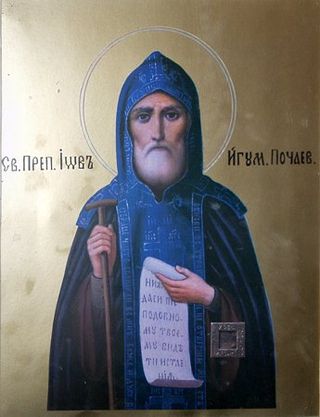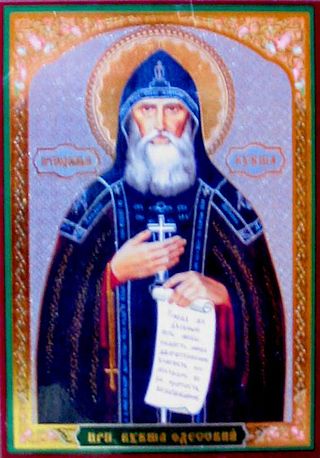
September 27 - Eastern Orthodox liturgical calendar - September 29

Anthony of Kiev, also called Anthony of the Caves, was a monk and the founder of the monastic tradition in Kievan Rus'. Together with Theodosius of Kiev, he co-founded the Kiev Pechersk Lavra.

August 6 - Eastern Orthodox liturgical calendar - August 8

August 14 - Eastern Orthodox liturgical calendar - August 16

Kyriakos the Anchorite was born in Corinth in the year 448.

Theodosius of Kiev or Theodosius of the Caves is an 11th-century saint who brought Cenobitic Monasticism to Kievan Rus' and, together with Anthony of Kiev, founded the Kiev Caves Lavra. A hagiography of Theodosius was written in the twelfth century.

February 9 - Eastern Orthodox liturgical calendar - February 11

March 3 - Eastern Orthodox liturgical calendar - March 5

Vladimir, baptismal name: Vasily Nikiforovich Bogoyavlensky, was a bishop of the Russian Orthodox Church. He was appointed to the position of Metropolitan of Moscow and Kolomna between 1898 and 1912, Metropolitan of St. Petersburg and Ladoga between 1912 and 1915, and the Metropolitan of Kiev and Galicia between 1915 and 1918. Murdered by Bolshevik soldiers in 1918, Metropolitan Vladimir was glorified as a Hieromartyr by the Russian Orthodox Church in 1992.

Job of Pochayev, to the world Ivan Zalizo, in Great Schema John was an Eastern Orthodox monk and saint.

Macarius of the Yellow Water Lake and the Unzha, the Miracle Worker was a Russian Orthodox monk and saint. He is credited with the founding of four monasteries in the Middle and Upper Volga regions of Russia.

Ephraim II of Pereyaslav, also Ephraim of the Caves or Ephraim, Bishop of Pereslav - is an Eastern Orthodox saint, who was bishop of Pereiaslav in what is now Ukraine).

Kuksha of Odessa, born Kuzma Kirillovich Velichko, was an imperial Russian priest and a Ukrainian Orthodox Church saint who was canonized in 1995.

Barlaam of Kiev was the first abbot of the Kiev Pechersk Lavra, serving together with St. Anthony of Kiev. He is regarded as a saint of the Russian Orthodox Church, with a feast day of 19 November.

Alipy of the Caves was an Eastern Orthodox saint, monk and famous painter of icons from the cave monastery of Kiev Pechersk Lavra. Saint Alipy was a disciple of Greek icon painters from Constantinople and considered to be the first icon painter of Kievan Rus.

Gerasimus of the Jordan was a Christian saint, monk and abbot of the 5th century AD.
Venerable Adrian of Ondrusov was a Russian Orthodox monk and saint, venerated as a Wonderworker.

December 1 - Eastern Orthodox liturgical calendar - December 3

December 12 - Eastern Orthodox liturgical calendar - December 14

December 28 - Eastern Orthodox liturgical calendar - December 30












